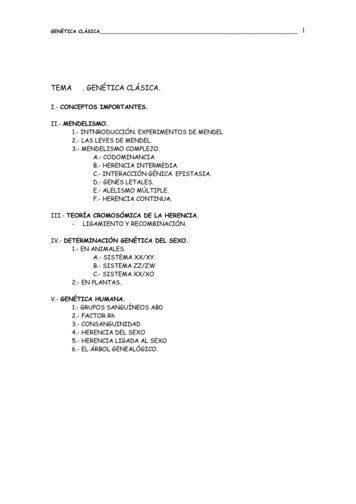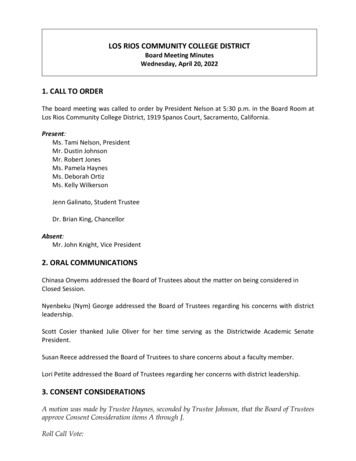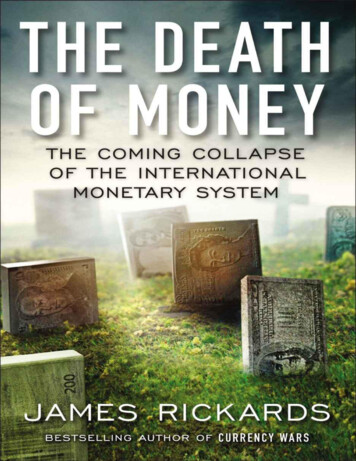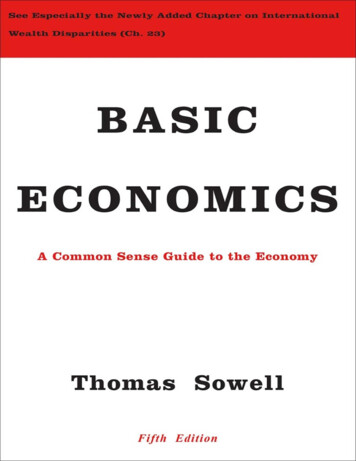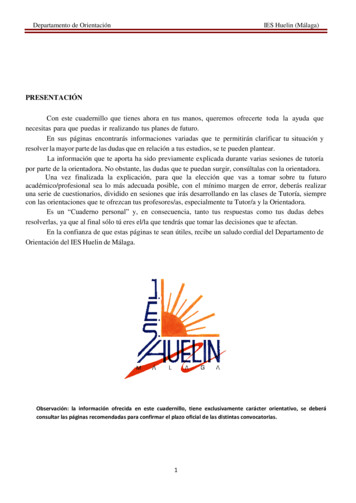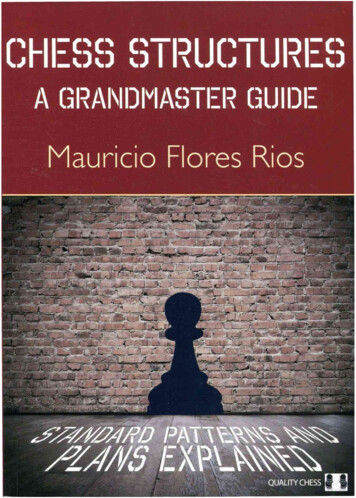
Transcription
Mauricio Flores Rios provides an in-depth study of the 28most common structures in chess practice.In Chess Structures -A Grandmaster Guide you will find: Carefully selected model games showing eachstructure's main plans and ideasStrategic patterns to observe and typical pitfalls to avoid50 positional exercises with detailed solutionsGM Axel Bachmann from the Foreword:"Chess Structures - A Grandmaster Guide is an excellentselection of model games. By studying the 140 games and fragments inthis book, the reader will learn many of the most important plans,patterns and ideas in chess."Mauricio Flores Rios is a grandmaster from Chile.He achieved the title at eighteen, and is a regular member of Chile'sOlympiad team. Mauricio combines his career as a chess playerand trainer with his PhD studies in Mathematics at the Universityof Minnesota. 2 4.9911 000-79 7 817 8 4 8 30 0 07 29.955 2995
Chess StructuresA Grandmaster GuideByMauricio Flores RiosQuality Chesswww.qualitychess.co. uk
First edition 2015 by Quality Chess UK LtdCopyright 2015 Mauricio Flores RiosChess Structures -A Grandmaster GuideAll rights reserved. No part of this publication may be reproduced, storedin a retrieval system or transmitted in any form or by any means, electronic,electrostatic, magnetic tape, photocopying, recording or otherwise, without priorpermission of the publisher.Paperback ISBN 978-1-78483-000-7Hardcover ISBN 978-1-78483-001-4All sales or enquiries should be directed to Quality Chess UK Ltd,20 Balvie Road, Milngavie, Glasgow G62 7TA, United KingdomPhone 44 141 204 2073e-mail: info@qualitychess.co. ukwebsite:www.qualitychess.co.ukDistributed in North America by National Book NetworkDistributed in Rest of the World by Quality Chess UK Ltd throughSunrise Handicrafts, ul. Skromna 3, 20-704 Lublin, PolandTypeset by Jacob AagaardProofreading by Andrew Greet, Colin McNab and Daniel McGowanEdited by David Friedgood and John ShawCover design bywww.adamsondesign.comAuthor photograph by Luciana MoralesPrinted in Estonia by Tallinna Raamatutriikikoja LLC
ContentsForeword by Axel BachmannKeys to Symbols used and BibliographyPrefaceIntroductionFamily One - d4 and . dS1234The IsolaniHanging PawnsCaro-Kann FormationSlav Formation5The Carlsbad Formation7Griinfeld Centre6StonewallFamily Two - Open Sicilian8NajdorfType I10The Hedgehog911NajdorfType IIThe MaroczyFamily Three - Benoni1213Asymmetric BenoniSymmetric BenoniFamily Four - King's Indian14KID Type I16KID Type III151718KID Type IIOpen KIDKID ComplexFamily Five - French19FrenchType I21FrenchType III20FrenchType 23338353364383
Miscellaneous22Various Structures400The Panov Structure403The 3-3 vs. 4-2 StructureThe Dragon FormationThe Scheveningen StructureThe Benko StructureThe Closed Ruy LopezThe Lopez s437Solutions460Name IndexAdrnowledgementsI would like to thank the Quality Chess editorial team for believing in the project this book proposed.In particular I would like to thank David Friedgood and John Shaw for a wonderful job editing mymanuscript.The content of this book could not have been presented as well without the help of Aura Salazar andJavier Cortes who carefully studied earlier versions of this work and provided many useful suggestionsto make the exposition clearer. Their questions and criticism encouraged me to expand certain topicsand find examples to illustrate my message in a better way.Finally, I would like to thank Aura for encouraging me to regain my ambition in chess, both as a playerand trainer. This ambition and her support drove me through the challenging process of writing thisbook.
ForewordI first met Mauricio ten years ago, as we both competed in Pan-American youth competitions. Later weboth received a chess scholarship to attend the University ofTexas at Brownsville. We were teammatesfor four years and spent countless hours studying chess together, though our training preferences werevery different. Mauricio read books, analyzed his games and prepared openings. I did these things too,but in reality the vast majority of my time was spent looking over current chess games and playing.I was surprised when Mauricio told me he had written a book partially inspired by my trainingmethods, and I was certainly interested to see what was in it.The truth about my training method is that looking over a game for j ust a couple of minutes canactually be a wonderful investment, ifdone correctly. The key is searching for repeating patterns; thistakes some practice but is feasible. In my career I have seen close to 1 00,000 chess games, includingmost of the grandmaster-level games played over the past decade. The cumulative experience fromspending a minute or two on each of these games has allowed me to gain an excellent positionalunderstanding. Staring at a position for a few seconds is often enough for me to see who is better,which plans will work, which pieces should be traded, etc.Acquiring such a level of experience and positional knowledge requires many years. Going throughthousands and thousands of games takes a very long time, even if you only spend a couple of minuteson each. Most importantly, being able to actually see the patterns does not come easily to everyone.Addressing these two difficulties is exactly the purpose of this book.Chess Structures A Grandmaster Guide is an excellent selection of model games. By studying the1 40 games and fragments in this book, the reader will learn many of the most important plans,patterns and ideas in chess. The organization of this book is particularly helpful in this regard. Thepawn structure is the most important factor to determine the nature of a game; therefore, studyingmodel games classified by structure allows the reader to acquire reliable strategic knowledge muchmore easily. Mauricio's detailed explanations allow the reader to identify the key elements in eachexample. Moreover, each game constitutes a building block toward the understanding of the structureas a whole.I am certain the readers of this book will find it both useful and entertaining. They will complete theopening phase understanding the strategic landscape of the position. Most importantly, studying thisbook will help them to better understand the opening itself, and even to choose variations dependingon what middlegame position they wish to play. I give this book my highest recommendation, and Ifeel sure readers will profit from it.-GM Axel BachmannCiudad del Este, ParaguayDecember 20 1 4
Key to symbols usedWhite is slightly better -- a;Black is slightly betterWhite is betterBlack is betterWhite has a decisive advantageBlack has a decisive advantageequalitywith compensationftwith counterplaymunclear?a blundera weak movea good move!!!?!#an excellent movea move worth consideringa move of doubtful valuemateBibliographyAvrukh: Grandmaster Repertoire 1, Quality Chess 2008Avrukh: Grandmaster Repertoire 2, Quality Chess 2010De la Villa: Dismantling the Sicilian, New in Chess 2010Delchev & Semkov: The Safest Sicilian, Chess Stars 2006Gligoric: King's Indian Defence: Mar del Plata Variation, Batsford 2003Grau: Tratado General De Ajedrez, Ediciones Colihue 1998Kasparov: The Test of Time, Pergamon 1986Polugaevsky: The Sicilian Labyrinth: Volumes I & II, Pergamon 1991Sokolov: Winning Chess Middlegames, New in Chess 2009Soltis: Pawn Structure Chess, Batsford 2013PeriodicalsMega Database 2013ChessBase MagazineThe Week in ChessChess Informant
PrefaceThe idea for this book was in the back of my mind for several years before coming to fruition. The bookwas born out of my desire to guide players who, like me, struggle to apply their strategic knowledge toa practical game. My aim is to provide something new to chess literature; to write the book I shouldhave studied myself earlier in my career. This is not the typical strategy book, but before I tell you whatthis book is, let me tell you how I realized this book is necessary, especially for self-learners.My progress in chess was very fast, but very difficult, even frustrating. Due to geographicaland financial constraints I drew most of my knowledge from books, rather than learning from anexperienced master. I studied many strategy books and I remember embracing every word in them asa piece of gold written in ink. However, as I scaled the rating ladder I was dazzled by my inability tocorrectly evaluate positions despite my supposedly vast strategic knowledge. I was well versed in modemstrategy but sometimes the concepts in my books were contradictory, or difficult to apply in practice.I often lost games without ever understanding the reason; my books had no answers!By the time I had become a FIDE Master, I had concluded that the strategic rules in my booksonly worked sometimes, and this was not good enough. I was afraid to use potentially incorrect rulesand I changed my style to avoid dealing with them. I became a strong tactician and avoided strategyat all costs. Unfortunately, I could not always obtain sharp positions and in quiet games my lack ofunderstanding often led me to lose miserably. In fact, I became a grandmaster at eighteen knowingless than half of this book's contents.There already exist dozens of books providing an excellent introduction to chess strategy, and Irecommend you read one. These books are a starting point, but they are insufficient. They teachstrategic elements without shedding much light on which factors will play a bigger role in a specificposition. It is like giving you several tools without telling you which one to use. A different class ofstrategy book provides many concrete examples and shows how the strategic tools are selected andused. Such books are often entertaining and even inspiring, but they lack specificity. At times readingthese books can leave you more confused than before, as you have learned rules but do not exactlyknow when to apply them. My experience as a coach has only confirmed this phenomenon.Chess Structures A Grandmaster Guide emphasizes clarity, precision and completeness overgenerality. I do not intend to teach rules applicable to every position. Such rules typically do not exist.Moreover, even if such rules existed, the chance that such a complex message will be misunderstood isfar too high. Let's not risk it! My aim is to provide an easy-to-understand strategic guide to the mostfrequently-occurring classes of positions in chess. I hope readers will find this helpful, as it greatlyreduces ambiguity; it is clear when rules will be valid and when they will not. In this sense, this bookis a collection of analyzed model games, logically organized into families of similar positions withcommon strategic ideas. As Capablanca said in his book Chess Fundamentals, every player should havea collection of games and ideas within his chess knowledge. This book intends to provide developingplayers with a fine selection of such games and ideas. These games are presented within the context ofwell-defined classes, to enhance the learning process and prevent confusion.Naturally, the best (and least ambiguous) way to classify chess positions is based on their pawnstructure. I divide this book into twenty-four chapters, which discuss the most interesting and-
8Prefacecommon structures in modern practice. These positions encompass a wide variety of openings andmiddlegames, which are present in the vast majority of all chess games. I hope my readers will findthis book to be a practical and, most importantly, an accessible guide to learning how these specificpositions should be conducted.Mauricio Flores RiosMinneapolis, December 20 1 4
IntroductionWhat you will find in this bookThis book is divided into twenty-two chapters describing some of the most important and commonstructures in chess. Two final chapters contain a compilation of exercises and detailed solutions.Deciding which structures deserved a chapter, and which did not, proved challenging, but I am satisfiedwith the final selection. Chapters are ordered so that similar structures are dose to one another. Infact, these structures are implicitly divided into five classes or families, each of which is more closelyassociated with one particular type of opening. Learning all structures within a family is very useful,as players must frequently decide between two options that yield different, yet related, structures. It ishelpful to know which structure will prove more favourable. These five families are as follows:Family One: d4 and . d5This family consists of the structures that will typically arise when the moves d2-d4 and . . . d7 -d5 occurearly in the game. Typical openings would be the Queen's Gambit Orthodox Defence, the Slav orthe Queen's Indian Defence, but there are many others, such as the Scandinavian, the Caro-Kann orthe Alapin Variation against the Sicilian Defence. This family encompasses Chapters 1 through 7. Inaddition, I discuss the Panov structure in the Caro-Kann and the 3-3 vs. 4-2 pawn structure, whichare related to this family, in Chapter 22.Family Two: Open SicilianThis family includes those structures that typically occur in the Open Sicilian. It focuses on twotypes of positions: those that occur when Black plays . . . e7-e5 instead of . . . e7-e6; and then Hedgehogand Maroczy positions. This family spans Chapters 8 through 1 1 . The Scheveningen and Dragonstructures are discussed in Chapter 22.Family Three: BenoniThis small family is devoted to those structures in which Black confronts the queen's pawn openingwith a . . . c7-c5 strategy and White replies with d4-d 5 . Later, when Black challenges the centre with. . . e7-e6 and . . . exd 5 , White must choose between cxd5 and exd 5 . Chapter 12 is devoted to studyingthe first option, which is typically known as a Benoni-type position, while Chapter 1 3 studies thealternative exd5. The related Benko structure is discussed in Chapter 22.Family Four: King's IndianThis family of five chapters is devoted to the multiple types of structure arising from the King's IndianDefence and its relatives. It is an extremely interesting and complex group of chapters to study, but itcontains plenty of tactical and strategic ideas. This family encompasses Chapters 14 to 1 8. The relatedstructures of the Closed Ruy Lopez and Lopez Formation are discussed in Chapter 22.
IOChess Structures-A Grandmaster GuideFamily Five: FrenchThis family of three chapters studies the pawn chains that typically arise in the French Defence. Itshould be noted that such structures often occur in the Sicilian, the anti-Sicilian, the English Opening,the Catalan and many others. It covers Chapters 1 9 to 2 1 .Miscellaneous ChapterAs you may see from the list above, Chapter 22 covers many structures. This chapter allows me todiscuss structures which are in some sense too "strategically limited" to deserve a full chapter, orsimply not so popular. Still, this chapter presents some of the interesting points of these structures,and deserves a close look.Structure selectionNaturally it would be impossible to cover every structure. It was a challenge to decide which structureswere worthy of inclusion, and which ones were not. I gave priority to the following:Strategic over tactical: I prefer discussing structures with a substantial strategic component. Structureslike the Dragon are discussed only briefly in Chapter 22. The reason is that tactics and openingknowledge tend to predominate, offering fewer long-term plans for us to study.Frequent over rare: I gave priority to those structures that arise more often, to offer a practical selectionthat the reader would be likely to encounter in play. Rare structures are not included.Fixed over flexible: Plans often begin to form after something happens with the pawn structure. Thatis, pawns are traded, a pawn chain is formed or there is tension in the centre. This creates a semi stable pawn structure. I only chose structures in which this was the case. If there is no pawn contactwhatsoever, then multiple options remain open, but the game is likely to reach one of our structuresat a later stage.Generally relevant over specific: Itried to avoid structures that occur in only one opening. For thisreason, I do not discuss the Exchange Variation of the Ruy Lopez, or the doubled pawn arising inthe Trompowsky, or the Winawer or MacCutcheon variations of the French. I do mention the Benkostructure in Chapter 22, but primarily because it is relevant to the asymmetric Benoni studied inChapter 1 2.ExercisesThe book concludes with a collection of fifty positional and tactical exercises, which reinforce theideas presented. I attempted to sort these problems from easiest to hardest, but this is merely my ownevaluation. If the reader struggles with later exercises, he is likely to find inspiration by solving earlierproblems. I provide detailed explanations to all of these exercises. In fact, some of these solutions conveypieces of knowledge that are not thoroughly developed in the corresponding chapter, in an attemptto keep this textbook concise and to make the exercises interesting. The reader is encouraged to firstattempt the exercises, and then read these solutions as an additional chapter of supplemental examples.
Introduction11Game selectionThe most challenging aspect of writing this book was selecting suitable examples for the conceptsI wanted to illustrate. I became so ambitious in my aim to provide a fine collection that I reviewedapproximately 20,000 recent games. When I selected games, I prioritized: Quality of executionTactical simplicity, when appropriate Recent games over older games Visually appealing games I want this book to explain mistakes made by all levels of players. I certainly did not want to omitthose mistakes the best players in the world could make. Excessive tactical complications often makethe strategic message rather blurry. Therefore, I avoided sharp tactics whenever it was possible andreasonable. Recent games have obvious advantages over older games. First, the reader is unlikely tobore himself with something he already knows; second, recent games illustrate mistakes players makenowadays, instead of those they used to make in the past. By the past, I mean three, four or fivedecades ago when strategic knowledge was far less advanced than it is today. Finally, I made an effort tochoose beautiful games whenever possible, simply because I would like the readers to enjoy this book.How to use this bookI understand many readers have limited time and do not wish to read an entire book if they are onlylikely to encounter a few of the pawn structures I discuss. For this reason, chapters are largely self contained, while similar chapters will be found dose to one another and arranged in a logical sequence.I took great care in ordering chapters so that all required knowledge would be available when needed.Many pawn structures can transpose to another. If structure B is likely to transpose to structure A,then I mention structure A at an earlier stage in the book. When the reader studies structure B, he willbe able to understand whether transposing to structure A is favourable or not. This makes the learningprocess run smoothly and comprehensively.Nevertheless, I would recommend that readers study this book in its entirety even if their currentrepertoire is unlikely to include all of these structures. Learning new structures opens your mind tonew ideas and could do wonders for your chess.Prior worksI am aware that other authors have already discussed similar structures as I do in my book. This factdrove me to expand this book beyond my original objective. I studied previous works in depth, as myambition was to produce the most detailed treatment on the subject yet. I am convinced this book willbe a great contribution to the study of chess structures.
Chapter 1The IsolaniaThe isolated queen's pawn - referred to here asthe isolani - is an extremely important pawnstructure. It arises in many opening variations;the Queen's Gambit Accepted, Slav, TarraschDefence, Sicilian Alapin or French Tarrasch toname a few. This structure is equally commonwith either colour, but for our discussion in thischapter we will assume it is White who has theisolani.Generally speaking, White has bettermiddlegame prospects, while Black has betterprospects in an endgame. Therefore, White'smain aim will be to build an attack, whileBlack's hope will be to neutralize such an attackand simplify the position, obtaining a superiorendgame.Let's discuss some specific plans:White's plans1. Create a kingside attack. Most standard planswill include the moves lll e 5 , ig5 and thebattery \Wd3-ic2. In some cases a piece sacrificeon the kingside is needed to break through thedefence. Rooks are typically placed on e 1 anddl (or c l ) , and a rook transfer via the thirdrank is possible.2. Break in the centre with d4-d 5 , trading pawnsand opening lines with an overwhelminginitiative (or even sacrificing a pawn with thesame purpose) .bcdefghBlack's plans1 . Trade pieces to win an endgame. In particular,exchange White's good bishop (the light squared bishop) .2. Place a knight on d5. This prevents the centralbreak d4-d5 , and controls some key squares.In an endgame a rook, bishop or even a kingwould be strong on this square.As we have seen, the plans in this structure arelogical and easy to understand. Playing thesepositions, on the other hand, can be tricky. Greatprecision is required when calculating, and agood positional understanding is necessary inorder to j udge when the isolani provides goodattacking chances (or other compensation) andwhen it is simply a weakness.The games in this chapter show all of thesecommon plans in some form or another. Thelast two games illustrate an interesting rule forevaluating whether the isolani provides enoughattacking chances. As we will learn, the key iswhether the player who has the isolani possesseshis good bishop. The chapter finishes with ashort fragment explaining the power of an isolaniwhich has advanced to the fifth rank.
Chapter 1-13The IsolaniVadim Zvjaginsev Rodrigo Vasqua-World Rapid Ch., Khanty-Mansiysk 20 1 3Learning objective:The central breakd4-d5 can be very powerful if Black doesnot effectively prepare against it.1 .c4 c6 2.e4 d5 3.exd5 tll f6 4.tll c3 cxd5 5.cxd5 xd5 6.tll f3 e6 7.i.c4 tll c6 8.0-0 i.e7 9.d40-0 10,gel tll f6The alternative 1 0 . . .if6!? certainly deservesattention. Black preserves the blockade on d 5 ,preventing possible d4-d5 breaks, and afterl 1 .llle4 simply 1 l . . .ie7.l l .a3A standard move, preventing tll b4-d5 andclearing the a2-square for the bishop.1 1 . a6?!This is somewhat slow, especially since. b7-b5 will greatly boost the strength of thebreak d4-d5 .More sensible was l l . . . b6!? and developing thebishop next move. 1 2. d3 (now the break 1 2.d5is not as effective, in view of 12 . tll a5 13 . .ia2tt:lxd5 1 4 .tll xd5 exd5 1 5 . xd5 .ie6 whenBlack was very close to equality in Durarbeyli Mirzoev, Baku 2009) 1 2 . . . .ib7 With a standardisolani position.1 2.i.a2This position has been reached over onehundred times on my database, and almost fiftyplayers chose:1 2 . b5?A very serious mistake.Black could have obtained a playable positionafter 12 . . . '!Wc7!? 1 3 . .ie3 d8 1 4 .'!Wc2 thoughWhite retains the initiative, and may proceedwith ad l followed by d4-d 5 .13.d5!abcdefghPerfect timing! Black's developmentinsufficient to parry all of White's threats.is13 . exd5 1 4.tll xd5 tll xd5 1 5. xd5 i.b7Of course not: 1 5 . . . xd5? 1 6 . .ixd5 .ib71 7 . .ixc6 .ixc6 1 8 . xe7 -16. h5 87654321abcdefghBlack finds himself in a very difficult position,as White is bringing his pieces into a kingsideattack and there is no time to organize a defence.16 . c71 6 . . . h6? loses by force after: 1 7 . .ixh6! gxh61 8 . g6t @hs 1 9.'!Wxh6t @gs 20 . .ib l f52 1 .ia2t f7 22 . g6t
14Family One - d 4 and .d 51 6 . . . d6?!This only aggravates Black's problems, becauseof:1 7.igS !Threatening Elad 1 .l 7 . . . Elad8If 1 7 . . . ixgS? 1 8 .lll x gS g6 1 9 . xg6hxg6 20.lll x f7 Elxf7 2 1 .Elad l and Black isdefenceless, for example: 2 1 . . .Elaf8 22.Eld7ic8 23.Elxf7 Elxf7 24.Ele8t1 8 .ixe7 lll xe7 1 9.lll gS g6 20.1t'tl'xg6!20. xh7t xh7 2 1 . lll xh7 'it xh7 22.Elxe7 idSgives Black drawing chances in the double rook ending20 . . . tt:l xg6 2 1 .lll x f7 Elxf7 22.Elad l ! Elxd l 23.Elxd lic6 24.Eld6 ie8 2 5 .Elxa6White had a winning endgame in Gurgenidze- Anikaev, Kislovodsk 1 972.16 . g6 l 7. h6 tt:l d4 1 8.lll gS ixgS 1 9.ixgS d6 20.Elad l If l 7 . . . Elae8? Black loses at once, in viewof: 1 8 .ixe7 Elxe7 1 9.Elxe7 xe7 20.Ele l f62 1 .lll g5 1t'tl'g6 22. xg6 hxg6 23.lll x f7!abcdefghBlack cannot recapture on f7 because 24.Ele8twins the rook.If l 7 . . . id6 the rook transfer decides the gameafter: l 8 .Ele4 lll eS l 9 .Elh4 h6 20.tt:lxeS ixe52 1 .ixh6 -18 . .!llxgS h6 19.ge3 lll aS?The final mistake in a very difficulc position.The only defence was 1 9 . . . lll eS preventing g6,but after 20.tt:le6! Xe6 2 1 .ElxeS White will be afull pawn up.20. g6! Nice finish!abcdefghWhite has a very dangerous dynamic advantage,due to the pair of bishops and the exposed blackking; for example, 20 . . . Elae8? loses immediatelyto 2 l .ixf7t!.17. gS!The most precise continuation.1 7.lll g S!? deserves attention. 17 . ixgS 1 8 .ixgSElae8 l 9.id2 with a big advantage due to thebishop pair and superior piece coordination.17 . xgS
Chapter 1 - The Isolani2 l . . . j:!fe8 does not help because of: 22.j:!h7!(but not 22.W'h7t? Wf8 when the king escapes)22 . . . W'e5 (or 22 . . . Wf8 23.W'xg7t We7 24.W'xf7t@d6 25 .W'xc7#) 23 .W'xf7t Wxh7 24.W'h5#22.j:!el15Alexander Huzman - Levon AronianPlovdiv 20 1 0Learning objective:Th e break . . . d5-d4(colours reversed) can be very strong,even in the form of a pawn sacrifice.1 .lLif3 d5 2.d4 lLif6 3.c4 e6 4.lLic3 .ib4 5 .ig5lLibd7 6.cxd5 exd5 7.Vffc2 c5 8.dxc5 h6 9.i.d20-0 10.a3?!This is a waste of time, since Black was goingto capture on c5 anyway. Instead theory suggests1 0.e3 ixc5 1 1 .j:! c l W'e7 1 2 . .ie2 a6 1 3.W'd3 lLib61 4.0-0 Carlsen - lvanchuk, Romania 20 1 1 .1 0 hc5 l 1 .e3 a6 1 2.ie2 b5 13.0-0 .ib71 4.j:!fdl ks 1 5 . .iel ges 16.j:!acl abcdeCheckmate is unavoidable.fgh1--0Final Remarks1. Black's position would have been much saferhad he kept his knight on d 5 .2. I t i s absolutely necessary t o prevent, or a t leastprepare against, a possible d4-d5 break.3. Black's biggest mistake was playing theweakening moves . . . a7-a6 and . . . b7-b 5 ,wasting time and making the d4-d5 break evenstronger.4. After d4-d5 was played, the position wasnearly lost and extremely difficult to conduct.87654321a16.tLif'BbcegBlack's knight is heading toward e6, in order tosupport the break . . . d5-d4.Somewhat stronger was 16 . . . tL:lb6! ? heading tothe c4-square. 1 7.tL:\d4 tL:lc4 1 8 . .if3 W'e7 1 9.h3W'e5 Black is slightly bercer as the isolatedd5-pawn is well supported, and he may createpressure on the centre and kingside with . . . .id6and . . . tL:le4.l 7.lLid4 V!fb6 1 8 .if3?!It was necessary to support the d4-square.Better was 1 8 .W'd2 tL:le6 1 9 .tLlxe6 W'xe6 (or
16Family One - d4 and . d519 . fxe6!?) 20 .if3 ib6 (20 . :!"1ed8!? ) witha standard isolani position. The d5-pawn isimmune to 2 1 . lll xd5 ? in view of 2 1 . . .E\xc l22.lll xf6t xf6 23.E\xc l ixf3 24.gxf3 xf3 when Black regains the pawn favourably.20 . d4!Aronian decides to sacrifice his isolated pawn,activating all of his pieces; Black seizes anoverwhelming initiative.2 1 .ixb?Much worse is: 2 l .exd4? ixf3 22.gxf3 lll xd423 . d l (or 23 . d3 'Li b3- ) 23 . . . E\xe l t!- 2 1 . xb?Of course not 2 l . . . dxc3? due to: 22.ixc8 cxd223.ixd2 -22.exd4Black is a pawn down, but now all his piecescollaborate in the attack.22 . lLie4! 23. ddl23 . xe4? '1Wxe4 24.ll:ixe4 E\xc l is also hopeless,but a better defence was 23.f3 lll xd2 24.'1Wxd2,though Black has a big advantage.23 . lLif4!- 19 . lLie6 20J d2?!The option 20.E\dd l ?! does not solve White'sproblems either. 20 . . . d4! 2 I .ixb7 xb7 22.exd4ll:i f4 23.f3 ll:i 6d5 and Black is threatening . . . ll:i xc3followed by . . . lll e2 or . . . :!"1e2. White is in deeptrouble, for example: 24.:!"1d2 a5 2 5 .'\Wb l lll xc326.2"1xc3 2"1xc3 27.bxc3 ll:i e2t 28. i h l ll:i xc329. al b4- The passed b-pawn, together withtactical threats on the first rank, make Black'sinitiative irresistible.Instead 20.:!"1h4! (as suggested by Krasenkow)allows White to stay in the game: 20 . . . :!"1c4 (thebreak 20 . . . d4?! is no longer effective, since after2 1 .ixb7 '1Wxb7 22.exd4 the key squares e4 andf4 are not available to Black's knights. On theother hand 20 . . . 2"1ed8!? is a worthy alternative,preparing . . . d5-d4 and taking advantage of themisplaced rook on h4) 2 l .:!"1xc4 dxc4 Blackhas some advantage owing to his superior piececoordination.abcdefghIt is possible that Huzman allowed the . . . d5-d4sacrifice because he did not expect Black's knightsto be so strong. Black is immediately threatening. . . lll xc3 , followed by . . . xg2#.24.dSBlocking the a8-h I diagonal.
Chapter 1Black wins an exchange and the game after 24.f3lll xc3 25 . .ixc3 tt:'ie2t 26.\t h 1 tt:'ixc l 27.l'hc l a5!followed by . b5-b4.-17The IsolaniRadoslaw Wojtaszek - Laurent FressinetWijk aan Zee 20 1 1Learning objectives:24 . aS!1 . The side which possesses an isolani inthe endgame is limited to passive defence.2. This game exemplifies how to makeprogress in such a situation.This strong move enables a quick win.Instead the tempting 24 . tt:'ixc3?! is less precise,since after 25 .ixc3 tt:'ie2t 26.\t h l tt:'ixc l27.\Wxc l White's d5-pawn allows him to holdfor longer.25.\Wb3 b4 26.axb4 axb4Threatening . . . tt:'ic5 , followed by . . . bxc3 .27.lll a227.tt:'ixe4 do
Mauricio Flores Rios provides an in-depth study of the 28 most common structures in chess practice. In Chess Structures -A Grandmaster Guide you will find: Carefully selected model games showing each structure's main plans and ideas Strategic patterns to observe and typical pitfalls to avoid 50 positional exercises with detailed solutions

